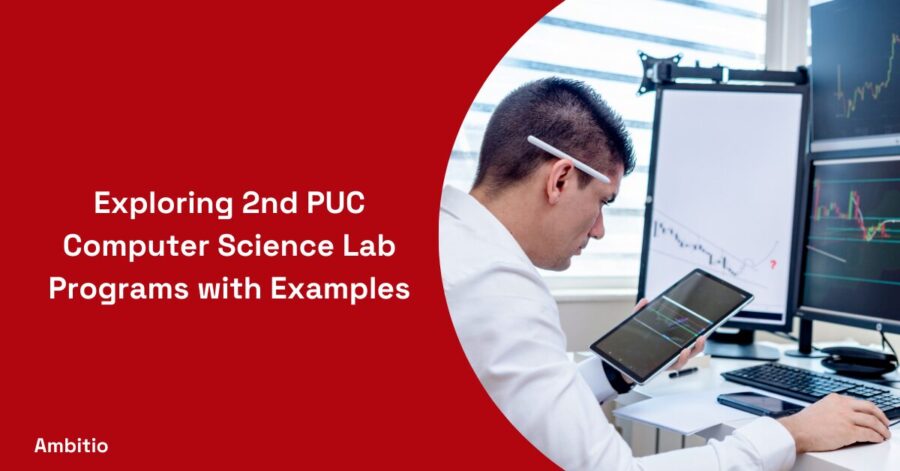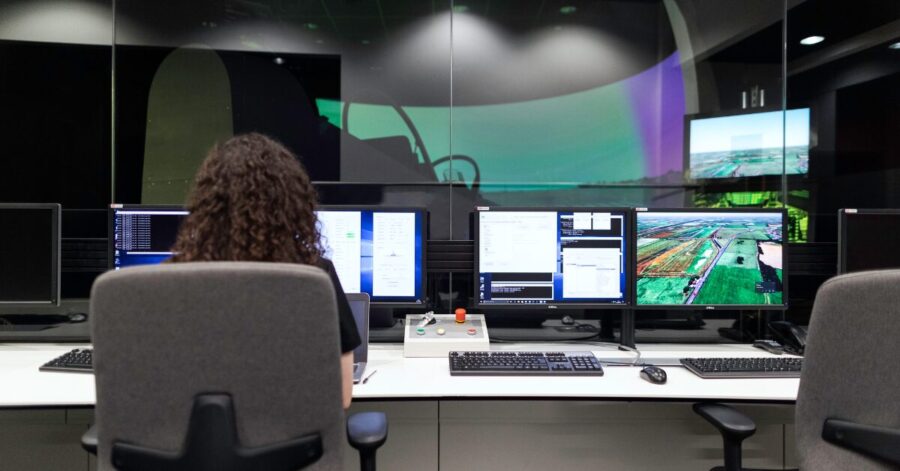7 March 2025
6 minutes read
Exploring 2nd PUC Computer Science Lab Programs with Examples

Welcome to this in-depth exploration of the 2nd PUC Computer Science Lab Programs. In this comprehensive guide, we will delve into the practical side of computer science, a crucial aspect of your 2nd PUC curriculum.
Whether you’re a Karnataka State Board student or just beginning your computer science journey, these programs are designed to provide you with hands-on experience to reinforce the theoretical concepts you learn in the classroom.
The Basics of 2nd PUC Computer Science Lab Programs
Before we dive into the specific programs, let’s establish a strong foundation by understanding the basics of computer science lab programs at the 2nd PUC level.

A program is a set of instructions written in a programming language that a computer can understand and execute. It serves as the bridge between human logic and computer processing. In your 2nd PUC computer science lab, you’ll start by grasping the core concepts of programming and its importance in today’s digital world.
Elements of a Program
Every program consists of fundamental elements such as variables, data types, and operators. These elements are building blocks for writing code. You’ll explore how to declare variables, use different data types (e.g., integers, strings), and perform operations on them.
Arrays and Tables
Arrays are essential data structures that allow you to store multiple values under a single variable name. Understanding arrays is crucial as they play a significant role in data manipulation. Additionally, you’ll learn how to create and work with tables, which are a structured way of organizing data.
Explained with Examples: HTML and SQL
Now that you have a solid grasp of programming basics, let’s move on to practical examples that will be covered in your 2nd PUC Computer Science Lab.
HTML Programming
HTML (Hypertext Markup Language) is the standard language used to create web pages. You’ll learn how to write HTML programs, understand their structure, and create web pages. This is a valuable skill in today’s digital age as web development continues to be in high demand.
SQL Queries
SQL (Structured Query Language) is essential for managing and querying databases. In this section, you’ll delve into SQL and discover how to perform operations on databases. You’ll write SQL queries to retrieve, update, and manipulate data, a critical skill for anyone interested in data-driven applications.
Finding Frequencies and More: Advanced Programs
In this section, we’ll explore more advanced programs that go beyond the basics and challenge your problem-solving skills.
Programs to Find Frequency
Finding the frequency of elements in a dataset is a common task in data analysis and statistics. You’ll write programs to calculate the frequency of specific elements in an array, a valuable skill for data-related tasks.
Calculating Balances and Interest
Financial calculations are another practical application of programming. You’ll learn how to write programs to calculate balances, interest, and other financial metrics. These skills are not only useful in the classroom but also in real-life financial planning.
Function-Based Programs
Functions are blocks of reusable code that perform specific tasks. You’ll understand the concept of functions in programming and how to create and use them effectively. This is a fundamental concept that will serve you well as you progress in your computer science journey.
Practical Programs and Resources for Success
In your 2nd PUC Computer Science Lab, practical programs are the heart of your learning experience. These programs not only reinforce the theoretical concepts taught in the classroom but also equip you with valuable problem-solving skills.

In this section, we will explore the practical programs you’ll encounter and the resources available to ensure your success.
1. Download Resources: One of the first steps in preparing for your computer science lab practicals is to gather the necessary resources. These resources include:
- Practical Programs: Your course materials should provide a list of practical programs that you’ll need to complete. These programs often cover a wide range of topics, from basic programming concepts to more advanced data manipulation.
- PDFs: Look for PDF documents that offer detailed explanations and step-by-step instructions for each program. These can serve as valuable reference materials as you work on your assignments.
- Previous Year Questions: Reviewing questions from previous years can give you insight into the types of problems that might be presented in your exams. It’s a great way to familiarize yourself with the exam format.
By gathering these resources early on, you’ll have a comprehensive toolkit to support your learning and practice.
2. Important Questions: Not all topics and programs are of equal weight in your curriculum. Some concepts may be more critical than others for your exams.
To maximize your preparation efficiency, identify and focus on important questions and topics. Here’s how:
- Consult Your Syllabus: Your syllabus outlines the topics that will be covered in your exams. Pay close attention to these areas as they are likely to contain important questions.
- Seek Guidance: Don’t hesitate to ask your instructors or fellow students for guidance on which topics are considered crucial. They can provide insights based on their experience.
- Prioritize Practice: Allocate more of your study time to practicing and mastering these important questions. This focused approach can significantly boost your confidence for the exam.
3. Syllabus Coverage: Comprehensive coverage of your syllabus is key to performing well in your computer science lab exams. Ensure that you’ve thoroughly understood and practiced all the topics and programs outlined in your syllabus. Here’s how to approach syllabus coverage:
- Create a Study Plan: Develop a study plan that allocates sufficient time to each topic. Make sure you’ve dedicated enough time to cover the entire syllabus well in advance of your exams.
- Regular Practice: Consistent practice is crucial. Work on practical programs regularly to reinforce your understanding and build proficiency.
- Practice Tests: Take practice tests that cover the entire syllabus. This simulates exam conditions and helps you identify areas that may need further review.
4. Guidance and Support: Don’t hesitate to seek guidance and support when you encounter difficulties. Your instructors, teachers, and classmates are valuable resources. Here’s how to make the most of their support:
- Ask Questions: If you’re stuck on a program or concept, don’t be afraid to ask questions in class or during lab sessions. Clarifying doubts promptly can save you a lot of time and frustration.
- Study Groups: Forming study groups with classmates can be highly beneficial. You can collaborate on solving programs, share insights, and learn from each other’s strengths.
- Online Forums: Explore online forums and communities dedicated to computer science. Websites like Stack Overflow can be a goldmine of information and solutions to common programming problems.
5. Practice and Patience: Mastering practical programs takes practice and patience. It’s normal to encounter challenges and errors along the way. Here are some tips to keep in mind:
- Debugging Skills: Develop strong debugging skills. The ability to identify and fix errors in your programs is a valuable skill that will serve you well in your computer science journey.
- Persistence: If a program doesn’t work initially, don’t give up. Debugging is an integral part of programming. Keep trying, and you’ll eventually find the solution.
- Learn from Mistakes: Mistakes are opportunities to learn. When you encounter errors, take the time to understand why they occurred and how to avoid them in the future.
Supplement Your Learning: YouTube and Online Resources
In this digital age, there are various ways to supplement your learning. Let’s explore how online resources can enhance your understanding of the 2nd PUC Computer Science Lab Programs.
YouTube Channel
If you prefer visual and interactive learning, consider subscribing to our YouTube channel. You’ll find video explanations and demonstrations that complement your textbook knowledge.
Online Resources
The internet is a treasure trove of additional materials, tutorials, and practice exercises. We’ll guide you on where to find online resources to further enhance your computer science skills.
Shaping Your Future
As you embark on this journey of exploring 2nd PUC Computer Science Lab Programs, remember that computer science has the power to shape your future. In an increasingly digital world, the skills you acquire in this course will open doors to various career opportunities.
Conclusion
In conclusion, 2nd PUC Computer Science Lab Programs are not just a mandatory part of your curriculum; they are a gateway to understanding the world of programming and its real-world applications.
By mastering these programs and honing your problem-solving skills, you’ll be well-prepared for future academic and professional endeavors.
Embrace the challenges, practice diligently, and watch as your proficiency in computer science grows, opening doors to exciting opportunities in the digital age with Ambitio
FAQs
What is the significance of 2nd PUC Computer Science Lab Programs?
These programs provide practical, hands-on experience, helping you apply theoretical knowledge to real-world scenarios.
How can I access practical programs and resources?
You can download practical programs, PDFs, and previous year questions to enhance your preparation.
Are there video tutorials available for these programs?
Yes, you can subscribe to our YouTube channel for video explanations and demonstrations.
What are the primary objectives of 2nd PUC Computer Science Lab Programs?
The primary objectives are to provide hands-on experience and apply theoretical knowledge to real-world scenarios.
What programming languages are typically covered in 2nd PUC Computer Science Lab Programs?
Typically, C++ is covered, with possible inclusion of HTML and SQL.
What are some common lab programs in 2nd PUC Computer Science?
Programs include swapping numbers, arithmetic operations, and calculating financial metrics.
How can I access resources for 2nd PUC Computer Science Lab Programs?
Resources can be accessed through educational websites and course materials.

You can study at top universities worldwide!
Get expert tips and tricks to get into top universities with a free expert session.
Book Your Free 30-Minute Session Now! Book a call now




























